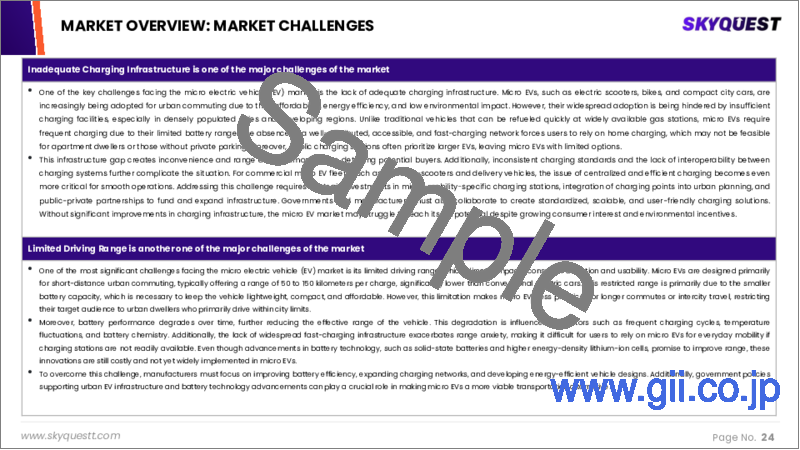|
|
市場調査レポート
商品コード
1610822
マイクロEV(電気自動車)の市場規模、シェア、成長分析、車両タイプ別、動力源別、用途別、最終用途別、地域別 - 産業予測、2024年~2031年Micro Electric Vehicle Market Size, Share, Growth Analysis, By Vehicle Type, By Power Source, By Application, By End Use, By Region -Industry Forecast 2024-2031 |
||||||
|
|||||||
| マイクロEV(電気自動車)の市場規模、シェア、成長分析、車両タイプ別、動力源別、用途別、最終用途別、地域別 - 産業予測、2024年~2031年 |
|
出版日: 2024年12月09日
発行: SkyQuest
ページ情報: 英文 178 Pages
納期: 3~5営業日
|
全表示
- 概要
- 目次
マイクロEV(電気自動車)の世界市場規模は、2022年に81億米ドルと評価され、予測期間中(2024-2031年)のCAGRは12.1%で、2023年の90億8,000万米ドルから2031年までに202億米ドルに成長する見通しです。
自動車の排出ガス削減への世界のシフトと電気自動車(EV)技術への投資の増加は、今後数年間でマイクロEV(電気自動車)の売上を大幅に押し上げるとみられます。主な促進要因としては、化石燃料価格の上昇や厳しい排出規制に加えて、急速な都市化や交通渋滞の深刻化が挙げられます。バッテリー技術の進歩は、超小型EVの市場ポテンシャルをさらに高めることが期待されます。さらに、充電インフラへの投資の拡大が、この分野の企業に新たな機会をもたらすと期待されています。しかし、限られた消費者意識、バッテリー廃棄に関する懸念、速度や航続距離の制限などの課題も残っており、市場成長の妨げになる可能性があります。マイクロEV(電気自動車)の可能性を最大限に引き出すには、こうした障害に対処することが極めて重要になります。
目次
イントロダクション
- 調査の目的
- 調査範囲
- 定義
調査手法
- 情報調達
- 二次データと一次データの方法
- 市場規模予測
- 市場の前提条件と制限
エグゼクティブサマリー
- 世界市場の見通し
- 供給と需要の動向分析
- セグメント別機会分析
市場力学と見通し
- 市場概要
- 市場規模
- 市場力学
- 促進要因と機会
- 抑制要因と課題
- ポーター分析と影響
- 競争企業間の敵対関係
- 代替品の脅威
- 買い手の交渉力
- 新規参入業者の脅威
- 供給企業の交渉力
主な市場の考察
- 重要成功要因
- 競合の程度
- 主な投資機会
- 市場エコシステム
- 市場の魅力指数(2023年)
- PESTEL分析
- マクロ経済指標
- バリューチェーン分析
- 価格分析
- 技術の進歩
- 規制情勢
- ケーススタディ
マイクロEV(電気自動車)市場規模:車両タイプ別& CAGR(2024-2031)
- マイクロカー
- マイクロLCV
マイクロEV(電気自動車)市場規模:動力源別& CAGR(2024-2031)
- バッテリー電気自動車(BEV)
- プラグインハイブリッド電気自動車(PHEV)
マイクロEV(電気自動車)市場規模:用途別& CAGR(2024-2031)
- パーソナルモビリティ
- シェアードモビリティ
マイクロEV(電気自動車)市場規模:最終用途別& CAGR(2024-2031)
- 住宅
- 商業
マイクロEV(電気自動車)市場規模:地域別& CAGR(2024-2031)
- 北米
- 米国
- カナダ
- 欧州
- 英国
- ドイツ
- スペイン
- フランス
- イタリア
- その他欧州地域
- アジア太平洋地域
- 中国
- インド
- 日本
- 韓国
- その他アジア太平洋地域
- ラテンアメリカ
- ブラジル
- その他ラテンアメリカ地域
- 中東・アフリカ
- GCC諸国
- 南アフリカ
- その他中東・アフリカ
競合情報
- 上位5社の比較
- 主要企業の市場ポジショニング(2023年)
- 主な市場企業が採用した戦略
- 市場の最近の動向
- 企業の市場シェア分析(2023年)
- 主要企業の企業プロファイル
- 会社概要
- 製品ポートフォリオ分析
- セグメント別シェア分析
- 収益の前年比比較(2021-2023)
主要企業プロファイル
- Italcar Industrial S.r.l.
- Polaris Inc.
- Shandong Shifeng(Group)Co., Ltd.
- PMV Electric Pvt. Ltd.
- Alke
- Suzhou Eagle Electric Vehicle Manufacturing Co., Ltd.
- Mahindra Electric Mobility Limited
- Renault S.A.
- Yamaha Golf-Car Company
- TOYOTA MOTOR CORPORATION
- Textron Inc.
- Tesla, Inc.
- BYD Company Ltd.
- NIO Inc.
- Smart Automobile Co., Ltd.
結論と推奨事項
Global Micro Electric Vehicle Market size was valued at USD 8.1 Billion in 2022 and is poised to grow from USD 9.08 Billion in 2023 to USD 20.2 Billion by 2031, at a CAGR of 12.1% during the forecast period (2024-2031).
The global shift towards reducing vehicle emissions and increased investments in electric vehicle (EV) technology are set to significantly boost the sales of micro electric vehicles in the coming years. Key drivers include rapid urbanization and escalating traffic congestion, alongside rising fossil fuel prices and stringent emission regulations. Advancements in battery technology promise to further enhance the market potential for micro EVs. Additionally, growing investments in charging infrastructure are expected to create new opportunities for companies in this sector. However, challenges remain, including limited consumer awareness, concerns over battery disposal, and restrictions in speed and range, which may hinder market growth. Addressing these obstacles will be crucial for unlocking the full potential of micro electric vehicles.
Top-down and bottom-up approaches were used to estimate and validate the size of the Global Micro Electric Vehicle market and to estimate the size of various other dependent submarkets. The research methodology used to estimate the market size includes the following details: The key players in the market were identified through secondary research, and their market shares in the respective regions were determined through primary and secondary research. This entire procedure includes the study of the annual and financial reports of the top market players and extensive interviews for key insights from industry leaders such as CEOs, VPs, directors, and marketing executives. All percentage shares split, and breakdowns were determined using secondary sources and verified through Primary sources. All possible parameters that affect the markets covered in this research study have been accounted for, viewed in extensive detail, verified through primary research, and analyzed to get the final quantitative and qualitative data.
Global Micro Electric Vehicle Market Segmental Analysis
Global Micro Electric Vehicle Market is segmented by Vehicle Type, Power Source, Application, End Use and Region. Based on Vehicle Type, the market is segmented into Microcars, Micro LCVs. Based on Power Source, the market is segmented into Battery Electric Vehicles (BEVs), Plug-in Hybrid Electric Vehicles (PHEVs). Based on Application, the market is segmented into Personal Mobility, Shared Mobility. Based on End Use, the market is segmented into Residential, Commercial. Based on Region, the market is segmented into North America, Europe, Asia Pacific, Latin America and Middle East & and Africa.
Driver of the Global Micro Electric Vehicle Market
The Global Micro Electric Vehicle market is primarily driven by the increasing demand for efficient mobility solutions, fueled by rapid urbanization and escalating traffic congestion worldwide. As cities become more densely populated and traditional transportation options struggle to adapt, micro electric vehicles emerge as an ideal solution, seamlessly navigating narrow, crowded streets. Their compact design and impressive efficiency make them particularly suited for bustling urban environments, allowing for convenient transportation. Consequently, the growing need for practical and effective modes of transport is expected to significantly enhance the appeal and adoption of micro electric vehicles in the market moving forward.
Restraints in the Global Micro Electric Vehicle Market
The Global Micro Electric Vehicle market faces significant restraints primarily due to the limited range and speed characteristics inherent to these vehicles. Their compact design restricts the distance they can travel and the speed at which they operate, which in turn hampers broader adoption across various applications. Consequently, potential buyers seeking a multifunctional transportation solution may be deterred, as these limitations do not meet their diverse mobility requirements. As a result, the overall growth and development potential of the market are stunted, posing a challenge to the widespread acceptance of micro electric vehicles in the transportation sector.
Market Trends of the Global Micro Electric Vehicle Market
The Global Micro Electric Vehicle market is experiencing a significant trend towards the integration of smart features, driven by consumer demand for enhanced connectivity and convenience. Companies are increasingly incorporating IoT connectivity, GPS tracking, and mobile app integration into their vehicles, making them more appealing to tech-savvy customers. This trend not only enhances user experience but also promotes efficient vehicle management and monitoring. As urbanization continues to rise and the need for sustainable transport solutions grows, micro electric vehicle manufacturers are strategically focusing on these innovations to boost their market presence and sales potential, positioning themselves favorably in a competitive landscape.
Table of Contents
Introduction
- Objectives of the Study
- Scope of the Report
- Definitions
Research Methodology
- Information Procurement
- Secondary & Primary Data Methods
- Market Size Estimation
- Market Assumptions & Limitations
Executive Summary
- Global Market Outlook
- Supply & Demand Trend Analysis
- Segmental Opportunity Analysis
Market Dynamics & Outlook
- Market Overview
- Market Size
- Market Dynamics
- Driver & Opportunities
- Restraints & Challenges
- Porters Analysis & Impact
- Competitive rivalry
- Threat of substitute
- Bargaining power of buyers
- Threat of new entrants
- Bargaining power of suppliers
Key Market Insights
- Key Success Factors
- Degree of Competition
- Top Investment Pockets
- Market Ecosystem
- Market Attractiveness Index, 2023
- PESTEL Analysis
- Macro-Economic Indicators
- Value Chain Analysis
- Pricing Analysis
- Technological Advancement
- Regulatory Landscape
- Case Studies
Global Micro Electric Vehicle Market Size by Vehicle Type & CAGR (2024-2031)
- Microcars
- Micro LCVs
Global Micro Electric Vehicle Market Size by Power Source & CAGR (2024-2031)
- Battery Electric Vehicles (BEVs)
- Plug-in Hybrid Electric Vehicles (PHEVs)
Global Micro Electric Vehicle Market Size by Application & CAGR (2024-2031)
- Personal Mobility
- Shared Mobility
Global Micro Electric Vehicle Market Size by End Use & CAGR (2024-2031)
- Residential
- Commercial
Global Micro Electric Vehicle Market Size by Region & CAGR (2024-2031)
- North America, (by Vehicle Type, by Power Source, by Application, by End Use)
- US
- Canada
- Europe, (by Vehicle Type, by Power Source, by Application, by End Use)
- UK
- Germany
- Spain
- France
- Italy
- Rest of Europe
- Asia-Pacific, (by Vehicle Type, by Power Source, by Application, by End Use)
- China
- India
- Japan
- South Korea
- Rest of Asia Pacific
- Latin America, (by Vehicle Type, by Power Source, by Application, by End Use)
- Brazil
- Rest of Latin America
- Middle East & Africa, (by Vehicle Type, by Power Source, by Application, by End Use)
- GCC Countries
- South Africa
- Rest of Middle East & Africa
Competitive Intelligence
- Top 5 Player Comparison
- Market Positioning of Key Players, 2023
- Strategies Adopted by Key Market Players
- Recent Developments in the Market
- Company Market Share Analysis, 2023
- Company Profiles of All Key Players
- Company Details
- Product Portfolio Analysis
- Company's Segmental Share Analysis
- Revenue Y-O-Y Comparison (2021-2023)
Key Company Profiles
- Italcar Industrial S.r.l.
- Company Overview
- Business Segment Overview
- Financial Updates
- Key Developments
- Polaris Inc.
- Company Overview
- Business Segment Overview
- Financial Updates
- Key Developments
- Shandong Shifeng (Group) Co., Ltd.
- Company Overview
- Business Segment Overview
- Financial Updates
- Key Developments
- PMV Electric Pvt. Ltd.
- Company Overview
- Business Segment Overview
- Financial Updates
- Key Developments
- Alke
- Company Overview
- Business Segment Overview
- Financial Updates
- Key Developments
- Suzhou Eagle Electric Vehicle Manufacturing Co., Ltd.
- Company Overview
- Business Segment Overview
- Financial Updates
- Key Developments
- Mahindra Electric Mobility Limited
- Company Overview
- Business Segment Overview
- Financial Updates
- Key Developments
- Renault S.A.
- Company Overview
- Business Segment Overview
- Financial Updates
- Key Developments
- Yamaha Golf-Car Company
- Company Overview
- Business Segment Overview
- Financial Updates
- Key Developments
- TOYOTA MOTOR CORPORATION
- Company Overview
- Business Segment Overview
- Financial Updates
- Key Developments
- Textron Inc.
- Company Overview
- Business Segment Overview
- Financial Updates
- Key Developments
- Tesla, Inc.
- Company Overview
- Business Segment Overview
- Financial Updates
- Key Developments
- BYD Company Ltd.
- Company Overview
- Business Segment Overview
- Financial Updates
- Key Developments
- NIO Inc.
- Company Overview
- Business Segment Overview
- Financial Updates
- Key Developments
- Smart Automobile Co., Ltd.
- Company Overview
- Business Segment Overview
- Financial Updates
- Key Developments





